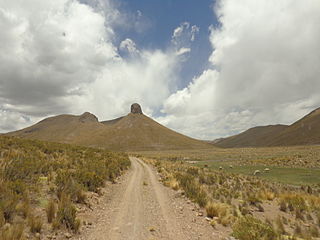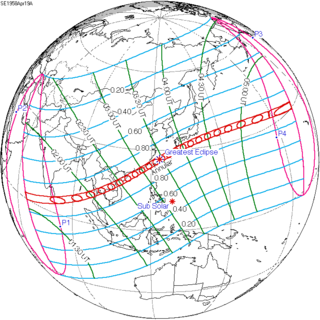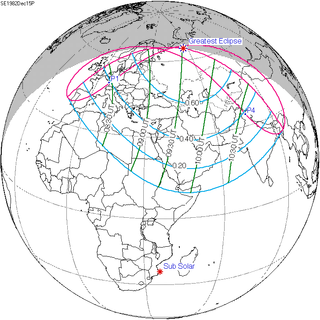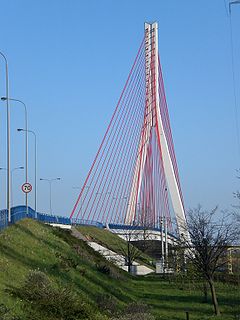| Suches River | |
|---|---|
 | |
| Country | Bolivia |
The Suches River is a river of Bolivia.
| Suches River | |
|---|---|
 | |
| Country | Bolivia |
The Suches River is a river of Bolivia.

The Chaco War was fought between Bolivia and Paraguay over control of the northern part of the Gran Chaco region of South America, which was thought to be rich in oil. It is also referred to as La Guerra de la Sed in literary circles, for being fought in the semi-arid Chaco. It was the bloodiest military conflict fought in South America during the 20th century, between two of its poorest countries, both having previously lost territory to neighbors in 19th-century wars.

Abel Iturralde is one of the twenty provinces of the Bolivian La Paz Department. It is situated in its northern part. Its name honors Abel Iturralde Palacios, a Bolivian politician. Madidi National Park is partially in this province.

Eliodoro Camacho is a province in the La Paz Department in Bolivia situated at Lake Titicaca. Its seat is Puerto Acosta.

José María Linares is a province in the eastern parts of the Bolivian department of Potosí. Its capital is Puna.
Catacora Municipality is the second municipal section of the José Manuel Pando Province in the La Paz Department, Bolivia. Its seat is Catacora.

Quime Municipality is the second municipal section of the Inquisivi Province in the La Paz Department in Bolivia, located south-east of the city of La Paz. Its seat is Quime.

Santiago de Machaca is the first municipal section of the José Manuel Pando Province in the La Paz Department, Bolivia. Its seat is Santiago de Machaca.

Puerto Acosta or Waychu (Aymara) is a town in the La Paz Department, Bolivia.

Puerto Carabuco is a location in the La Paz Department in Bolivia.

A partial solar eclipse took place on February 15, 2018. A solar eclipse occurs when the Moon passes between Earth and the Sun, thereby totally or partly obscuring the image of the Sun for a viewer on Earth. A partial solar eclipse occurs in the polar regions of the Earth when the center of the Moon's shadow misses the Earth.

The solar eclipse of January 6, 2019 was a partial solar eclipse that was visible in East Asia and North Pacific.

An annular solar eclipse occurred on Tuesday, May 10, 1994. It was visible over a wide swath of North America, from Baja California across the Midwest of the United States up through Ontario and Nova Scotia in Canada.

An annular solar eclipse occurred on April 29, 1976. A solar eclipse occurs when the Moon passes between Earth and the Sun, thereby totally or partly obscuring the image of the Sun for a viewer on Earth. An annular solar eclipse occurs when the Moon's apparent diameter is smaller than the Sun's, blocking most of the Sun's light and causing the Sun to look like an annulus (ring). An annular eclipse appears as a partial eclipse over a region of the Earth thousands of kilometres wide. Totality was visible from North Africa, Greece, Turkey, Middle East, central Asia, India, China. 5 of the 14 eight-thousanders in Pakistan and China—Nanga Parbat, K2, Broad Peak, Gasherbrum II and Gasherbrum I, lie in the path of annularity.

An annular solar eclipse occurred on April 18–19, 1958. A solar eclipse occurs when the Moon passes between Earth and the Sun, thereby totally or partly obscuring the image of the Sun for a viewer on Earth. An annular solar eclipse occurs when the Moon's apparent diameter is smaller than the Sun's, blocking most of the Sun's light and causing the Sun to look like an annulus (ring). An annular eclipse appears as a partial eclipse over a region of the Earth thousands of kilometres wide. Annularity was visible in the Maldives, Nicobar Islands, Burma, Thailand including the capital city Bangkok, Cambodia, Laos, North Vietnam and South Vietnam, China, British Hong Kong, Taiwan, Ryukyu Islands and Japan. It was the fourth central solar eclipse visible from Bangkok from 1948 to 1958, where it is rare for a large city to witness 4 central solar eclipses in just 10 years. Places east of International Date line witnessed the eclipse on April 18th (Friday).

An annular solar eclipse will occur on June 1, 2030. A solar eclipse occurs when the Moon passes between Earth and the Sun, thereby totally or partly obscuring the image of the Sun for a viewer on Earth. An annular solar eclipse occurs when the Moon's apparent diameter is smaller than the Sun's, blocking most of the Sun's light and causing the Sun to look like an annulus (ring). An annular eclipse appears as a partial eclipse over a region of the Earth thousands of kilometres wide.

A total solar eclipse occurred on Thursday, November 3, 1994. A solar eclipse occurs when the Moon passes between Earth and the Sun, thereby totally or partly obscuring the image of the Sun for a viewer on Earth. A total solar eclipse occurs when the Moon's apparent diameter is larger than the Sun's, blocking all direct sunlight, turning day into darkness. Totality occurs in a narrow path across Earth's surface, with the partial solar eclipse visible over a surrounding region thousands of kilometres wide. Totality was visible in Peru, northern Chile, Bolivia, northern Argentina, Paraguay including the northeastern part of its capital Asunción, Brazil and Gough Island of British overseas territory of Saint Helena, Ascension and Tristan da Cunha. The Iguazu Falls, one of the largest waterfalls systems in the world, also lies in the path of totality.

An annular solar eclipse will occur on September 12, 2034. A solar eclipse occurs when the Moon passes between Earth and the Sun, thereby totally or partly obscuring the image of the Sun for a viewer on Earth. An annular solar eclipse occurs when the Moon's apparent diameter is smaller than the Sun's, blocking most of the Sun's light and causing the Sun to look like an annulus (ring). An annular eclipse appears as a partial eclipse over a region of the Earth thousands of kilometres wide.

A partial solar eclipse occurred on December 15, 1982. A solar eclipse occurs when the Moon passes between Earth and the Sun, thereby totally or partly obscuring the image of the Sun for a viewer on Earth. A partial solar eclipse occurs in the polar regions of the Earth when the center of the Moon's shadow misses the Earth.

The Third Millennium John Paul II Bridge is a cable-stayed road bridge which spans the Martwa Wisła River in Gdańsk, Poland.

Escoma is a location in the La Paz Department in Bolivia. It is the seat of the Escoma Municipality, one of five municipalities of the Eliodoro Camacho Province. In 2009 Escoma had an estimated population of 712.
Coordinates: 15°41′38″S69°09′22″W / 15.6939°S 69.1561°W

A geographic coordinate system is a coordinate system that enables every location on Earth to be specified by a set of numbers, letters or symbols. The coordinates are often chosen such that one of the numbers represents a vertical position and two or three of the numbers represent a horizontal position; alternatively, a geographic position may be expressed in a combined three-dimensional Cartesian vector. A common choice of coordinates is latitude, longitude and elevation. To specify a location on a plane requires a map projection.
| This La Paz Department geography article is a stub. You can help Wikipedia by expanding it. |
| This article related to a river in Bolivia is a stub. You can help Wikipedia by expanding it. |